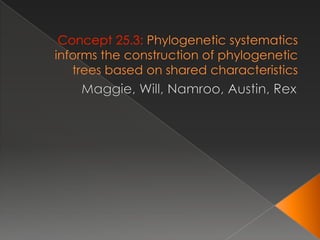
25.3
- 2. -Cladogram: shows patterns of shared characteristics -Clade: a group of species including ancestral and descendants in the tree
- 4. I. Monophyletic: regular clade II. Paraphyletic: ancestor is present, but not all descendants III. Polyphyletic: descendants are present, but no ancestor
- 5. D E G H J K C F I B A
- 6. D E G H J K C F I B A
- 7. D E G H J K C F I B A
- 8. ―Character‖ refers to any feature that a particular taxon process Shared primative character – A character that is shared beyond the taxon we are trying to define Shared derived character – An evolutionary novelty unique to a particular clade
- 9. Outgroup comparison is used to differentiate between shared derived characters and shared primitive characters Ingroup – The various species we are studying Outgroup – A species or group of species that is closely related to the ingroup.
- 10. Phylograms – present sequences of events relative to each other. Ultrametric Trees – Present sequences based on the actual times they occurred.
- 11. Length of branch corresponds to the amount of changes that occurred. A long branch means more changes in DNA.
- 13. The lengths of the branches are the same lengths for each lineages. The tree draws information from the fossil record.
- 14. Proterozoic Paleozoic Mesozoic Cenozoic Millions of 542 251 65.5 years ago
- 15. Systematists: › Can never be sure of finding the single best tree in a large data set. › Narrow the possibilities by applying the principles of maximum parsimony and maximum likelihood. According to the principle of maximum parsimony, we should first investigate the simplest explanation that is consistent with the facts. The principle of maximum likelihood states that, given certain rules about how DNA changes over time, a tree can be found that reflects the most likely sequence of evolutionary events. Among phylogenetic hypotheses
- 16. Human Mushroom Tulip Human 30% 0 40% Mushroom 0 40% 0 Tulip (a) Percentage differences between sequences Figure 25.14 (a)
- 17. 25% 15% 15% 15% 20% 10% 5% 5% Tree 1: More likely Tree 2: Less likely (b) Comparison of possible trees Figure 25.14 (b)
- 18. Phylogenetic trees represent a possible way of how the species in it are related. Phylogenetic hypotheses can change with new evidence. Usually the most parsimonious tree is most likely Analogy-Homology issue The more matching base pairs the less probability they evolved independently
- 19. Parsimony more reliable if with longer segments. Accidentally mistaking an analogy for a homology is less likely to affect the tree if the clades are defined by several defined characters. Strongest hypotheses are supported by lots of morphological and molecular evidence and fossil evidence. Pg.502-503
- 20. APPLICATION In considering possible phylogenies for a group of species, systematists compare molecular data for the species. The most efficient way to study the various phylogenetic hypotheses is to begin by first considering the most parsimonious—that is, which hypothesis requires the fewest total evolutionary events (molecular changes) to have occurred. TECHNIQUE Follow the numbered steps as we apply the principle of parsimony to a hypothetical phylogenetic problem involving four closely related bird species. 1 First, draw the possible phylogenies for the species (only 3 of the 15 possible trees relating these four species are shown here). Species Species Species Species I II III IV I II III IV I III II IV I IV II III Three possible phylogenetic hypothese Sites in DNA sequence 1 2 3 4 5 6 7 2 Tabulate the molecular data for the species (in this simplified I A G G G G G T example, the data represent a DNA sequence consisting of just seven nucleotide bases). II G G G A G G G Species III G A G G A A T IV G G A G A A G I II III IV A G G G Bases at site 1 for each species 3 Now focus on site 1 in the DNA sequence. A single base- G G change event, marked by the crossbar in the branch leading Base-change to species I, is sufficient to account for the site 1 data. event G
- 21. THE END.
